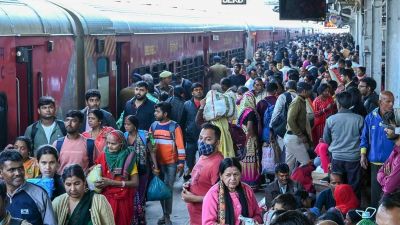There are several health challenges around the globe. These vary from outbreaks of vaccine-preventable diseases like measles also called rubella, and morbilli and diphtheria which is a contagious disease, increasing reports of drug-resistant pathogens, growing rates of obesity to the health impacts of environmental pollution and global climate change and multiple humanitarian crises.
To address these and different threats, 2019 sees the beginning of the World Health Organization’s new 5-year strategic plan – the thirteenth General Programme of labour. This plan focuses on a triple billion target: making one billion more people take pleasure in access to universal health coverage, one billion more people shielded from health emergencies and one billion more people relish higher health and well-being. Reaching this goal would require addressing the threats to health from a range of angles.
Here are 10 of the problems which will demand attention from WHO and health partners in 2019.
Air pollution and climate change
Nine out of 10 individuals breathe contaminated air every day. In 2019, pollution is taken into account by the UN because of the great environmental risk to health. Microscopic pollutants within the air will penetrate the circulatory and respiratory systems, damaging the lungs, heart, and brain, killing seven million individuals, untimely, once a year causing diseases like cancer, stroke, heart, and respiratory organ illness. Around 90% of those deaths are in low- and middle-income countries, with high volumes of emissions from the trade, transport, agriculture and furthermore as dirty cookstoves and fuels in homes.
The primary reason for pollution (burning fossil fuels) is additionally a significant contributor to temperature change, that impacts people’s health in numerous ways. Between the year 2030 and 2050, the temperature change is predicted to cause 2,50,000 further deaths per annum, from a dietary deficiency, malaria, diarrhoea and heat stress.
Non-communicable diseases
Non-communicable diseases, like diabetes, cancer and cardiovascular disease, are collectively responsible for over 70% of all deaths worldwide, or forty-one million individuals. This includes fifteen million individuals dying untimely, aged between thirty and sixty-nine.
Over 85% of those premature deaths are in low- and middle-income countries. The increase of those diseases has been driven by five major risk factors: tobacco use, physical inactivity, the harmful use of alcohol, unhealthy diets and pollution. These risk factors conjointly exacerbate mental state problems, that may originate from an early age: half of all psychological state begins by the age of fourteen, however, most cases go unseen and untreated – suicide is the second leading cause of death among 15-19 year-olds.
Among several things, this year WHO will work with governments to assist them to meet the global target of reducing physical inactivity by 15% by 2030.
Global influenza pandemic
The world will face another influenza pandemic, which is the only thing we don’t know when it will hit and how severe it will be. International defences are solely as effective because of the weakest link in any country’s health emergency state and response system. WHO is consistently observing the circulation of influenza viruses to notice potential pandemic strains: 153 establishments in 114 countries are concerned with international surveillance and response.
Fragile and vulnerable settings
More than 1.6 billion individuals (22% of the worldwide population) live in places where protracted crises (through a mixture of challenges like drought, famine, conflict, and population displacement) and weak health services leave them with no access to basic care. Fragile settings exist in most regions of the globe, and these are wherever half the key targets within the sustainable development goals, including on kid and maternal health, remains unmet. WHO will still add these countries to strengthen health systems so that they’re ready to answer outbreaks and furthermore are ready to deliver high-quality health services, as well as immunisation.
Also Read: A drowning world! Antarctic ice melting six times faster than it did in the 1980s
Antimicrobial resistance
The development of antivirals, antibiotics and antimalarials are some of modern medicine’s greatest successes. Now, with time these medicines are losing their potency. Antimicrobial resistance – the ability of bacterium, parasites, viruses and fungi to resist these medicines – threatens to send us back to a time when we were unable to treat infections like respiratory illness, Tuberculosis, Gonorrhoea, and gastrointestinal disorder. The shortcoming to stop infections may seriously compromise surgery and procedures like therapy.
Drug resistance is driven by the overuse of antimicrobials in people, however additionally in animals, particularly those used for food production, as well as in the environment. WHO is functioning with these sectors to implement a global action plan to tackle antimicrobial resistance by increasing awareness and information, reducing infection, and inspiring prudent use of antimicrobials.
Ebola and alternative high-threat pathogens
In 2018, the Democratic Republic of the Congo saw two separate Ebola outbreaks, both unfolded in cities having more than one million people. This shows that the context during which an epidemic of a high-threat infective agent like Ebola erupts is critical – what happened in rural outbreaks within the past doesn’t continually apply to densely inhabited urban areas or conflict-affected areas.
WHO’s R&D Blueprint identifies diseases and pathogens that have the potential to cause a public health emergency, however, lack effective treatments and vaccines. This watchlist for priority analysis and development includes Ebola, many alternative haemorrhagic fevers, Zika, Nipah, and Severe Acute Metabolism Syndrome (SARS), that represents the necessity to organize for an unknown infective agent that might cause a significant epidemic.
Weak primary health care
Primary health care is typically the first point of contact people have with their health care system, and ideally ought to offer comprehensive, affordable, community-based care throughout life. Primary health care can meet the maximum of a person’s health needs in their life. Health systems with robust primary health care are required to realize universal health coverage. Yet several countries don’t have adequate primary health care facilities. This neglect is also because of scarcity of resources in low- or middle-income countries. In 2019, WHO will work with partners to revitalize and strengthen primary health care in countries, and follow up informed specific commitments created within the Asthana Declaration.
Vaccine hesitancy
Vaccine hesitancy – the reluctance or refusal to immunize despite the supply of vaccines – threatens to reverse progress created in confronting vaccine-preventable diseases. Vaccination is one among the foremost cost-efficient ways of avoiding unwellness – it presently prevents 2-3 million deaths a year, and an extra 1.5 million may be avoided if world coverage of vaccinations improved. Measles, for instance, has seen a 30% increase in cases globally. The explanations for this rise are complex and not all of those cases are because of vaccine hesitancy.
In 2019, WHO will build up work to eliminate cervical cancer worldwide by increasing coverage of the HPV vaccine, among alternative interventions. 2019 may be the year when transmission of untamed poliovirus is stopped in the Afghanistan and Pakistan. WHO and partners are committed to supporting these countries to immunise all kids to eradicate this incapacitating unwellness permanently.
Dengue
Dengue, a mosquito-borne disease that causes flu-like symptoms and can be fatal and kill up to 20% of those with severe dengue fever, has been a growing threat for many years. A high variety of cases occur within the rainy seasons of nations like Bangladesh and India. Now, its season in these countries is continuing considerably, and therefore it is spreading to less tropical and more temperate countries like Nepal, that has not historically seen Dengue. A calculable 40% of the globe is in danger of dengue, and there are around 390 million infections a year. WHO’s dengue fever management strategy aims to scale back deaths by 50% by 2020.
HIV
The progress created against HIV has been monumental in terms of obtaining individuals tested, providing them with antiretrovirals (22 million are on treatment), and providing access to preventive measures like pre-exposure prophylaxis (PrEP, that is once individuals in danger of HIV take antiretrovirals to forestall infection).
However, the epidemic continues to rage with nearly 1,000,000 individuals once a year dying of HIV/AIDS. Since the start of the epidemic, seventy million individuals have acquired the infection, and concerning thirty-five million individuals have died. Today, around thirty-seven million worldwide abide HIV. Reaching individuals like sex workers, individuals in jail, men who have sex with men, or transgender individuals is massively difficult. Usually, these teams are excluded from health services. A bunch progressively tormented by HIV are young women and girls (aged 15–24), who are significantly at high risk and account for 1 in 4 HIV infections in sub-Saharan Africa despite being solely 10 per cent of the population.
This year, WHO will work with countries to support the introduction of self-testing, in order that additional individuals living with HIV understand their standing and may receive treatment (or preventive measures within the case of a negative check result). One activity is to act on new steering declared In Dec 2018, by WHO and therefore the International Labour Organization to support corporations and organizations to supply HIV self-tests within the workplace.









